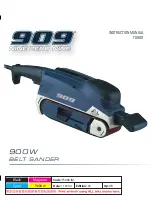
English–3
2 609 140 340 • 20.9.05
Noise/Vibration Information
Measured values determined according to EN 60745.
Typically the A-weighted sound pressure value of the
machine is 82 dB(A). Measuring uncertainty K=3 dB.
The noise level when working can exceed 85 dB(A).
Wear hearing protection!
The typically weighted acceleration is 6.5 m/s
2
.
Declaration of Conformity
We declare under our sole responsibility that this prod-
uct is in conformity with the following standards or
standardization documents: EN 60745 according to
the provisions of the directives 89/336/EEC,
98/37/EC.
Berner GmbH
Assembly
Dust/Chip Extraction
Integrated Dust Extraction with Dust Box
(see figure D1 — D4)
Attach the dust box
1
onto the outlet piece
8
until it
latches.
To empty the dust box
1
, press the latching levers
9
on
the side of the dust box (
n
). Pull off the dust box
toward the bottom (
o
).
Before opening the dust box
1
, it is recommended to
loosen the dust from the filter element by gently striking
it against a firm support (as shown in the figure).
Grasp the dust box
1
by the recessed grip, fold the filter
element
10
upward and empty the dust box. Clean the
thin plates of the filter element
10
with a soft brush.
Fire hazard! Avoid overheating
of the material being sanded
and of the power tool. Always empty the dust col-
lector before taking breaks.
Sanding dust in the
dust bag, fine dust filter, paper bag — or in the filter bag
or filter of the vacuum cleaner — can self-ignite under
unfavourable conditions such as from sparking while
sanding metals. Danger is especially given when the
sanding dust is mixed with particles of varnish, poly-
urethane remainders or other chemical materials, and
when the material being sanded is hot after prolonged
operation.
External Dust Extraction (see figure E)
Slide the extraction adapter
11
onto the outlet piece
8
.
Ensure that the latching levers of the extraction adapter
engage. The extraction adapter
11
accepts a vacuum
hose with a diameter of 19 mm.
For removal of the extraction adapter
11
, press the
latching levers together at the rear and pull the extrac-
tion adapter off.
The vacuum cleaner must be suitable for the material
being worked.
When vacuuming dry dust that is especially detrimental
to health or carcinogenic, use a special vacuum
cleaner.
Replacing the Sanding Sheet
Before any work on the machine itself, pull the
mains plug.
When attaching a new sanding sheet, remove any dust
or debris from the sanding plate
2
(e. g. with a brush).
To ensure optimum dust extraction, pay attention that
the punched holes in the sanding sheet match with the
holes in the sanding plate.
Sanding Sheets with Velcro Backing
The sanding plate
2
is fitted with Velcro backing for
quick and easy fastening of sanding sheets with Velcro
adhesion.
Before attaching the sanding sheet
4
, free the Velcro
backing of the sanding plate
2
from any debris by tap-
ping against it in order to enable optimum adhesion.
Position the sanding sheet
4
flush alongside one edge
of the sanding plate
2
, then lay the sanding sheet onto
the sanding plate and press it against it with a light turn-
ing motion in clockwise direction.
To remove the sanding sheet
4
, grasp it at one of the
tips and pull it off from the sanding plate
2
.
Sanding Sheets without Velcro Backing
(see figure A— C)
n
Press the release button
5
and keep it depressed.
o
Guide the sanding sheet
4
to the stop under the
opened front clamping bracket
6
and let go of the
release button
5
again. Pay attention that the sand-
ing sheet is clamped centrally.
p
Press the sanding sheet clamp
3
inward and pivot
it to the stop.
q
Fold the sanding sheet
4
firmly around the sanding
plate. Guide the other end of the sanding sheet
4
between the rear clamping bracket and the red
roller on the clamping bracket
3
.
r
Hold the sanding sheet tensely and press the
clamping bracket
3
toward the sanding plate to
lock the sanding sheet.
Jörn Werner
CEO
Hans-Peter Artmann
CFO
WARNING
OBJ_BUCH-2 609 140 340-001.book Page 3 Tuesday, September 20, 2005 10:02 AM













































